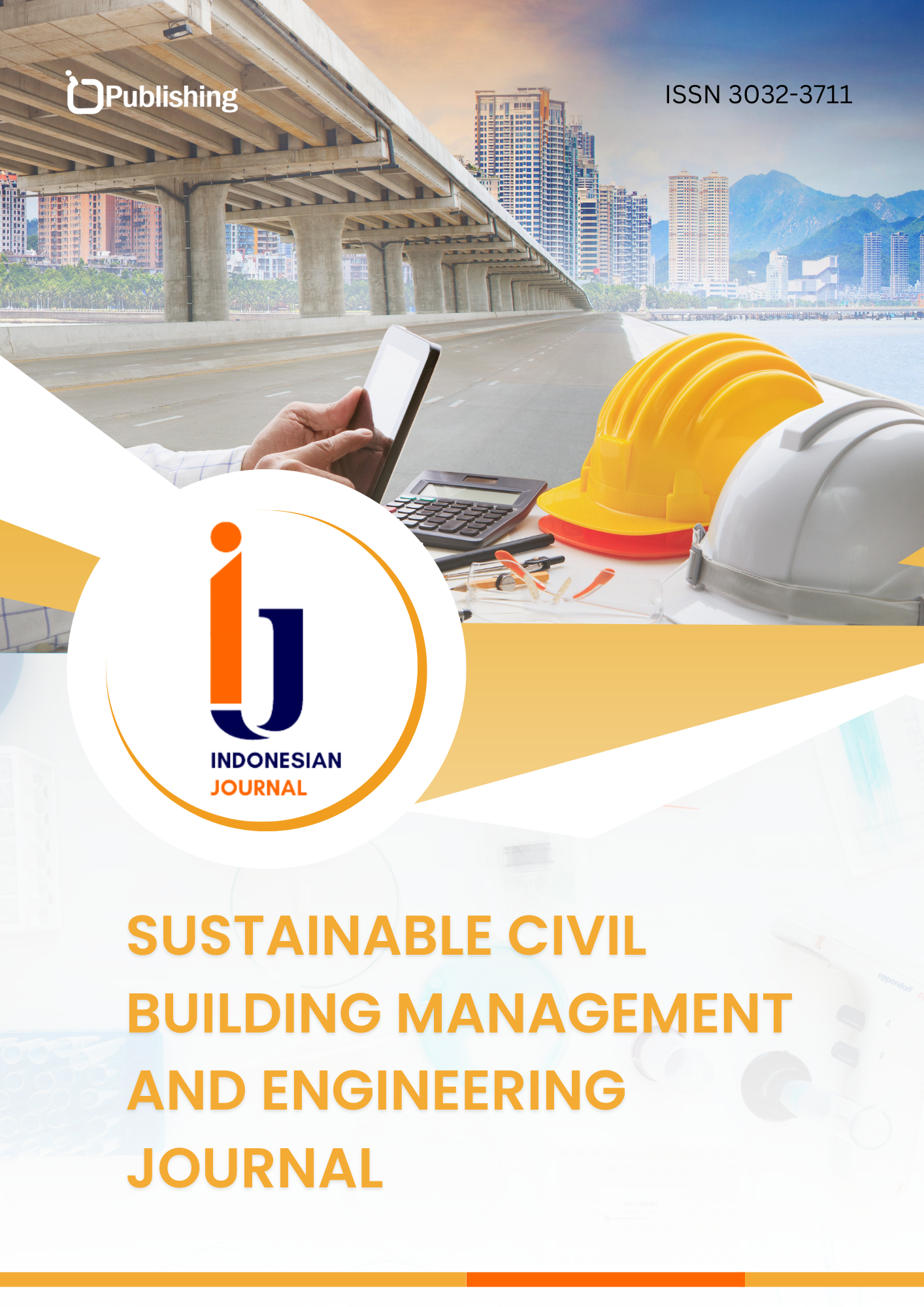Numerical Modeling of Soil Embankment on Soft Soil Using Variation of Expanded Polystyrene (EPS) Geofoam Material Type
DOI:
https://doi.org/10.47134/scbmej.v1i4.2871Keywords:
GeoStudio, EPS Geofoam, Variation of EPS Material Type, SettlementAbstract
Subgrade is the layer of soil that lies beneath the pavement. The subgrade plays an important role in supporting and spreading the load from the pavement to the underlying soil. Terzaghi, et al. (1967) state that soft soils can pose serious challenges in geotechnical engineering, due to their tendency to experience large settlement under structural loads. Handling soft soils often requires specialized methods such as preloading, vacuum consolidation, or the use of geosynthetics to improve stability. One of the geosynthetics used in handling soft soil is Expanded Polystyrene (EPS) Geofoam. This research aims to determine the settlement behavior of soil embankment on soft soil reinforced with EPS geofoam. The settlement behavior was obtained with the help of GeoStudio software. EPS geofoam has been used since 1960, this material weighs about 1% of the soil weight and less than 10% of the weight of other embankment materials. As a lightweight embankment material, EPS geofoam can reduce the load imposed on the embankment structure. Modeling of soil embankment on soft soil using various types of EPS geofoam material in this research uses GeoStudio software. The modeling analysis uses SIGMA/W in GeoStudio. Numerical modeling of variations in the type of EPS geofoam material in the embankment on soft soil gives the results of a decrease that is not too significant. The settlement results from modeling with GeoStudio are 0.33240 m for EPS 22, 0.33264 m for EPS 29, 0.33323 mm for EPS 39. EPS 39 provides 0.25% higher settlement than EPS 22.
References
AbdelSalam, S. S. (2019). Long Term Behavior of EPS Geofoam for Road Embankments. Sustainable Civil Infrastructures, 97–107. https://doi.org/10.1007/978-3-030-01944-0_8 DOI: https://doi.org/10.1007/978-3-030-01944-0_8
Akay, O. (2016). Slope stabilisation using EPS block geofoam with internal drainage system. Geosynthetics International, 23(1), 9–22. https://doi.org/10.1680/jgein.15.00028 DOI: https://doi.org/10.1680/jgein.15.00028
Akyelken, F. A. (2022). Experimental and Numerical Analyses of Buried HDPE Pipe with Using EPS Geofoam. KSCE Journal of Civil Engineering, 26(9), 3968–3977. https://doi.org/10.1007/s12205-022-1541-z DOI: https://doi.org/10.1007/s12205-022-1541-z
Amalu, P. A. (2024). Geofoam integrated separation layer for enhancing seismic resilience in modified piled raft foundations. Multiscale and Multidisciplinary Modeling, Experiments and Design. https://doi.org/10.1007/s41939-024-00474-8 DOI: https://doi.org/10.1007/s41939-024-00474-8
Edinçliler, A. (2014). Effects of EPS bead inclusions on stress-strain behaviour of sand. Geosynthetics International, 21(2), 89–102. https://doi.org/10.1680/gein.14.00001 DOI: https://doi.org/10.1680/gein.14.00001
Ekanayake, S. (2014). Attenuation of ground vibrations using in-filled wave barriers. Soil Dynamics and Earthquake Engineering, 67, 290–300. https://doi.org/10.1016/j.soildyn.2014.10.004 DOI: https://doi.org/10.1016/j.soildyn.2014.10.004
Firouzeh, S. H. (2022). Efficiency of various mitigation schemes in the alleviation of the destructive effect of reverse dip-slip fault rupture on surface and embedded shallow foundations using upper bound finite element limit analysis. Computers and Geotechnics, 142. https://doi.org/10.1016/j.compgeo.2021.104548 DOI: https://doi.org/10.1016/j.compgeo.2021.104548
Geofoam Technical Data Sheets. (n.d.). GeoFoam Concepts. Retrieved May 29, 2024, from https://geofoamconcepts.com/geofoam-technical-data/
Hidayat, I., & Suhendra, A. (2011). Aplikasi Geofoam Sebagai Material Timbunan di Atas Tanah Lunak. ComTech: Computer, Mathematics and Engineering Applications, 2(1), 106. https://doi.org/10.21512/comtech.v2i1.2722 DOI: https://doi.org/10.21512/comtech.v2i1.2722
Jauhari, N. (2024). Vibration mitigation using dual-open and infilled trenches in layered soil media: Field tests and numerical simulations. Computers and Geotechnics, 170. https://doi.org/10.1016/j.compgeo.2024.106283 DOI: https://doi.org/10.1016/j.compgeo.2024.106283
Jazebi, M. (2021). Efficiency of in-filled (geofoam) trenches in mitigating train-induced vibrations: A case study of Tehran-Tabriz railway. Construction and Building Materials, 309. https://doi.org/10.1016/j.conbuildmat.2021.125075 DOI: https://doi.org/10.1016/j.conbuildmat.2021.125075
Kamash, W. El. (2020). Optimizing the Unconnected Piled Raft Foundation for Soft Clay Soils: Numerical Study. KSCE Journal of Civil Engineering, 24(4), 1095–1102. https://doi.org/10.1007/s12205-020-0567-3 DOI: https://doi.org/10.1007/s12205-020-0567-3
Kavand, A. (2023). Field Testing on active isolation of vibrating foundations in Middle-frequency range. Construction and Building Materials, 374. https://doi.org/10.1016/j.conbuildmat.2023.130893 DOI: https://doi.org/10.1016/j.conbuildmat.2023.130893
Khalaj, O. (2020). The experimental investigation of behaviour of expanded polystyrene (EPS). IOP Conference Series: Materials Science and Engineering, 723(1). https://doi.org/10.1088/1757-899X/723/1/012014 DOI: https://doi.org/10.1088/1757-899X/723/1/012014
Kılıç, H. (2023). A Numerical Investigation of Induced and Embedded Trench Installations for Large-Diameter Thermoplastic Pipes under High Fill Stresses. Applied Sciences (Switzerland), 13(5). https://doi.org/10.3390/app13053040 DOI: https://doi.org/10.3390/app13053040
Liyanapathirana, D. (2016). Application of EPS geofoam in attenuating ground vibrations during vibratory pile driving. Geotextiles and Geomembranes, 44(1), 59–69. https://doi.org/10.1016/j.geotexmem.2015.06.007 DOI: https://doi.org/10.1016/j.geotexmem.2015.06.007
Meguid, M. A. (2017). Earth Pressure Distribution on a Rigid Box Covered with U-Shaped Geofoam Wrap. International Journal of Geosynthetics and Ground Engineering, 3(2). https://doi.org/10.1007/s40891-017-0088-4 DOI: https://doi.org/10.1007/s40891-017-0088-4
Özer, A. T. (2016). Laboratory study on the use of EPS-block geofoam for embankment widening. Geosynthetics International, 23(2), 71–85. https://doi.org/10.1680/jgein.15.00033 DOI: https://doi.org/10.1680/jgein.15.00033
Özer, A. T. (2021). Shear strength characteristics of interlocked EPS-block geofoam-sand interface. Geosynthetics International, 28(5), 521–540. https://doi.org/10.1680/jgein.21.00009 DOI: https://doi.org/10.1680/jgein.21.00009
Soundara, B. (2020). Experimental Investigation on the Swelling Behavior of Expansive Soils with EPS Geofoam Inclusion. Indian Geotechnical Journal, 50(4), 519–530. https://doi.org/10.1007/s40098-019-00385-3 DOI: https://doi.org/10.1007/s40098-019-00385-3
Terzaghi, K., & Ralph Brazelton Peck. (1967). Soil mechanics in engineering practice [by] Karl Terzaghi [and] Ralph B. Peck. New York Wiley.
Tran-Nguyen, H. H. (2022). Investigation of Key Properties of EPS Geofoams for Highway Embankments on Soft Ground. Geotechnical Engineering, 53(2), 35–42.
Witthoeft, A. F. (2018). Impacts of EPS inclusion density and backfill soil type on earth pressure reduction around a buried pipe. 11th International Conference on Geosynthetics 2018, ICG 2018, 2, 1680–1689.
Wardoyo, Sarwondo, Farah Destiasari, Wahyudin, Wiyono, Ginda Hasibuan, & William Pradana Sollu. (n.d.). Atlas Sebaran Tanah Lunak Indonesia (Andiani, Sugalang, & Dodid Murdohardono, Eds.; 2019th ed., p. 6) [Review of Atlas Sebaran Tanah Lunak Indonesia]. BADAN GEOLOGI Kementerian Energi dan Sumber Daya Mineral. (Original work published 2019)
Zianal, N. F. A., Yusof, M. F., Madun, A., Pakir, F., Abu Talib, M. K., & Abu Talib, Z. (2022). Numerical Modelling of Soft Soil Improvement Using Expanded Polystyrene Geofoam for Road Embankment. Journal of Sustainable Underground Exploration, 2(1). DOI: https://doi.org/10.30880/jsue.2022.02.01.007
Downloads
Published
How to Cite
Issue
Section
License
Copyright (c) 2024 Mohammad Sahrul R.

This work is licensed under a Creative Commons Attribution 4.0 International License.










